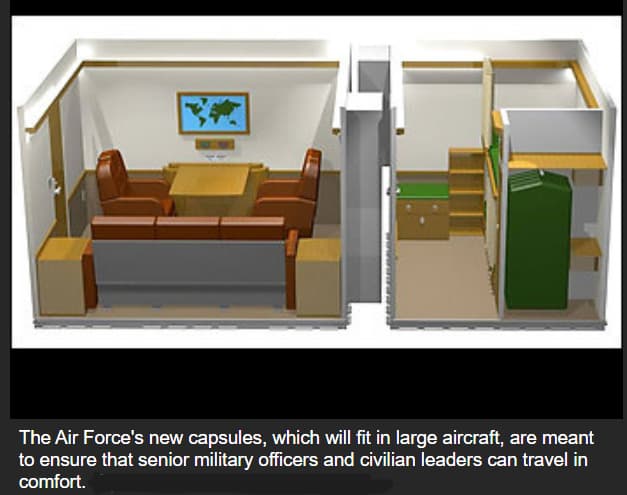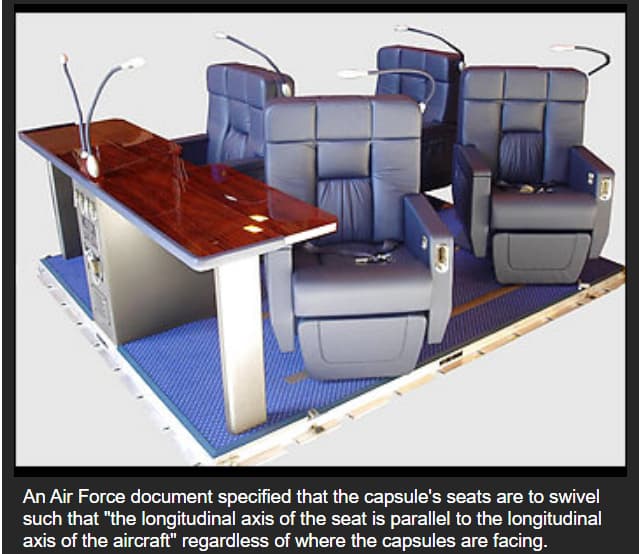Terrorism Funds May Let Brass Fly in Style
By R. Jeffrey Smith
Washington Post Staff Writer
Friday, July 18, 2008
The Air Force's top leadership sought for three years to spend counterterrorism
funds on "comfort capsules" to be installed on military planes that ferry senior
officers and civilian leaders around the world, with at least four top generals
involved in design details such as the color of the capsules' carpet and leather
chairs, according to internal e-mails and budget documents.
Production of the first capsule -- consisting of two sealed rooms that can fit into
the fuselage of a large military aircraft -- has already begun.

Air Force officials say the government needs the new capsules to ensure that leaders
can talk, work and rest comfortably in the air. But the top brass's preoccupation
with creating new luxury in wartime has alienated lower-ranking Air Force officers
familiar with the effort, as well as congressional staff members and a nonprofit
group that calls the program a waste of money.
Air Force documents spell out how each of the capsules is to be "aesthetically
pleasing and furnished to reflect the rank of the senior leaders using the capsule,"
with beds, a couch, a table, a 37-inch flat-screen monitor with stereo speakers, and
a full-length mirror.
The effort has been slowed, however, by congressional resistance to using
counterterrorism funds for the project and by lengthy internal deliberations about a
series of demands for modifications by Air Force generals. One request was that the
color of the leather for the seats and seat belts in the mobile pallets be changed
from brown to Air Force blue and that seat pockets be added; another was that the
color of the table's wood be darkened.
Changing the seat color and pockets alone was estimated in a March 12 internal
document to cost at least $68,240.
In all, for the past three years the service has asked to divert $16.2 million to
the effort from what the military calls the GWOT, or global war on terrorism.
Congress has twice told the service that it cannot, including an August 2007 letter
from Rep. John P. Murtha (D-Pa.) to the Pentagon ordering that the money be spent on
a "higher priority" need.
Officials say the Air Force nonetheless decided last year to take $331,000 from
counterterrorism funds to cover a cost overrun, partly stemming from the design
changes, although a senior officer said yesterday in response to inquiries that it
will reverse that decision.
The internal Air Force e-mails, provided to The Washington Post by the Project on
Government Oversight (POGO), a nonprofit Washington group, and independently
authenticated, make it clear that lower-ranking officers involved in the project
have been pressured to create what one described as "world class" accommodations
exceeding the standards of a regular business-class flight.
"I was asked by Gen. [Robert H.] McMahon what it would take to make the [capsule] .
. . a 'world class' piece of equipment," an officer at the service's Air Mobility
Command said in a March 2007 e-mail to a colleague, referring to the mobility
command's top officer then. "He said he wanted an assurance . . . that we would be
getting a world class item this week."
Air Force officials say the program dates from a 2006 decision by Air Force Gen.
Duncan J. McNabb that existing seats on transport planes, including some that match
those on commercial airliners, may be fine for airmen and troops but inadequate for
the top brass. McNabb was then the Air Mobility commander; he is now the Air Force's
vice chief of staff, and Defense Secretary Robert M. Gates nominated him in June to
become head of the military's Transportation Command.
In a letter of complaint sent yesterday to Gates, POGO asserted that the new
capsules will provide no special communications or work capabilities beyond those
already available for top officials on Air Force transport aircraft. It is "a gross
misuse of millions of taxpayer dollars that could otherwise be used to train and
equip soldiers," wrote Danielle Brian, the group's executive director.
She added that "in a time of war, it is critical for senior officials to visibly
prioritize the needs of the men and women on the frontline." The Air Force program,
she said, represents an "egregious failure of leadership."
A military officer familiar with the program, speaking on the condition of anonymity
because he was not authorized to speak about it, likewise said that its extravagance
has provoked widespread contempt among lower-ranking Air Force personnel. "This
whole program is an embarrassment," the officer said, particularly because transport
seating for troops en route to the battlefield is in his view generally shoddy.
The criticism is the latest in a series of volleys to hit the Air Force over the
past year, stemming from an inadvertent flight of nuclear warheads over the
continental United States, the mistaken transfer of secret nuclear-related materials
to Taiwan, and a corrupt $50 million contract for a Thunderbirds air show. Gates
fired the top two Air Force military and civilian leaders last month, citing defects
in their stewardship of nuclear arms.
The Air Force already has two trailers, known as Silver Bullets, that can be loaded
aboard large transports for use by top military and civilian officers, plus a fleet
of about 100 planes specifically meant for VIP travel. But McMahon, who is now the
Air Force's deputy chief of staff for logistics, installations and mission support,
said the new program was started because the service ferried more "senior travelers"
to distant regions after the attacks of Sept. 11, 2001, and identified a "gap" in
its capability.
It initially planned to build 10 of the capsules, he said, for use by four-star
generals, fleet admirals and federal officials at the level of assistant secretary
and above. "It is not opulent and it is not a box," McMahon said, but meant to match
the comfort level of the VIP fleet.

Explaining his instructions to subordinates, McMahon said he used the term world
class "in just about everything I discuss. . . . That represents an attitude." He
said he wanted to "create an environment that whoever was riding in that would be
proud of," the government would be proud of and "the people of the United States"
would be proud of.
Construction of what the Air Force initially termed the new Senior Leader Intransit
Comfort Capsules, or SLICC, has already begun, under a contract paid from general
Air Force funds. One of the 18-by-9-foot capsules has been partly completed. But
McMahon said the program has recently been downsized from 10 capsules to three, plus
the four pallets fitted with swiveling leather chairs, known as Senior Leader
Intransit Pallets, or SLIP.
The reason, he said, is that the Air Force has upgraded the VIP fleet by adding new
air defenses to the planes, reducing its need for new capsules. All four pallets
will be finished this year, McMahon said, but he added that building them is much
more complicated than "going down to your neighborhood store and buying a recliner
and slapping it" onto a platform.
Because of the cutback in the number of capsules and pallets, the program is
currently estimated to cost $7.6 million.
Air Force documents about the SLICC, dated June 8, 2006, emphasize the need to
install "aesthetically pleasing wall treatments/coverings" -- in addition to the
monitor, footrests and a DVD player. The beds, according to one document, must be
able to support a man with "no more than 50% compression of the mattress material."
The seats are to swivel such that "the longitudinal axis of the seat is parallel to
the longitudinal axis of the aircraft" regardless of where the capsules are facing,
the document specified.
In a draft document dated Nov. 15, 2006, that spelled out the requirements for the
SLICC, the word "Comfort" was repeatedly crossed out with a horizontal line and
replaced by a less cushy-sounding alternative, "Conference." McMahon said he thinks
the term "comfort" was dropped from the name to distinguish it from pallets of
latrines that could be loaded aboard military aircraft.
Although the program's estimated $20 million cost is nearly equivalent to what the
Pentagon spends in about 20 minutes, the e-mails show that small details have so far
received the attention of many high-ranking officers, including McMahon; Gen. Arthur
J. Lichte, the current Air Mobility commander; and Brig. Gen. Kenneth D. Merchant,
the mobility command's logistics director.
The leather and carpet color choices were made by McNabb, according to several of
the e-mails exchanged by lower-ranking officers, although a spokesman for the
general said those selections were McMahon's responsibility. The e-mails state that
McMahon ordered that the seats be re-covered, and one e-mail complains that the
contractor "would not swap out the brown seat belts for replacement blue seat
belts." The changes delayed the project by months and added to its cost.
McMahon said he does not recall intervening on the leather color change, but said he
was sure it was unrelated to the Air Force's color. He said that it was probably
because blue would not show dirt as much as tan or brown would.